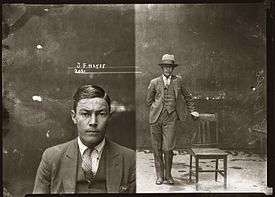John 'Chow' Hayes
| John Frederick Hayes | |
|---|---|
| Born |
7 September 1911 Paddington, New South Wales |
| Died |
7 May 1993 (aged 81) Lidcombe, New South Wales |
| Other names | Chow Hayes |
| Occupation | Stand-over Criminal |
| Criminal charge | Murder, Gun possession, Theft, Violent offence |
| Criminal penalty | Death, commuted to Life imprisonment |
| Spouse(s) | Gladys Muriel King |
| Children | 3 sons, 1 daughter |
| Conviction(s) | Murder, Theft, Gun crime |

John Frederick 'Chow' Hayes (7 September 1911 – 7 May 1993) was a violent Australian criminal who became known as Australia's first gangster.[1]
Early life
Hayes was born at the Sydney suburb of Paddington, New South Wales on 7 September 1911, the illegitimate son of Elizabeth Hayes who was a prostitute and petty criminal (although he lied about much of his early background in his biography). He was soon put into the care of his grandmother and an aunt, and was brought up by them. He lived his early years in the inner-city suburbs of Chippendale and Haymarket.
Hayes rarely attended school after his eighth birthday, and earned a living as a newspaper seller in the area around Central railway station known as Railway Square. He was caught for truancy on a number of occasions and was sent to boy reformatories. As a teenager he became involved with gang-related crime in and around his local area, namely shoplifting, petty theft and assault. Hayes was known as a major player in the Sydney Gang Wars of the late 1920s and 1930s and was known to police as an extremely violent person. In a show of bravado, in February 1939 Chow Hayes was shot at Glebe and taken to Royal Prince Alfred Hospital, although he discharged himself with the bullet still inside his body to avoid police interrogation.
Incidents like this were reported widely in the national media, and Chow Hayes's hard reputation grew.[2]
Adult life
Hayes' criminal career progressed as he grew older. A biography that was written about him in 1990 by David Hickie named "Chow Hayes, Gunman", suggested that he started carrying and using firearms in his late teens. He became involved in larger robberies and stand-over extortion scams, which enriched his ego, but also gave him a very bad reputation with the general public and thus became a menace to the police.
Chow Hayes spent many years of his life in prison for a succession of crimes which included small felonies such as drunkenness to capital crimes such as murder. In 1938 he shot Henry Jack Baker, the de facto partner of Sydney crime czar Kate Leigh, but he escaped prosecution.
On New Year's Day 1945 he shot and killed a fellow Sydney gangster named Eddie Weyman (1915-1945), but he was later found not guilty at trial although in the David Hickie biography, Hayes admitted that he had indeed killed Weyman and got away with it.[3] In 1951 he murdered a fellow gangster William 'Bobby' Lee (1915-1951) at a Sydney inner city nightclub. After hiding from police for six weeks, he (and his accomplice William 'Joey' Hollebone) was finally caught by the notorious Sydney detective Ray "Gunner" Kelly. He was tried twice for this offence before he was found guilty in 1952.[4] Hayes served over fifteen years in prison for that murder.
He was freed from prison under licence in the mid-1960s, and was soon back extorting money from many of Sydney's most dangerous criminals, including crooked casino boss Dick Reilly and the 'king' of Sydney's brothel business Joe Borg. Hayes was initially implicated in the murder of underworld heavy Joe Borg in May 1968, although the police quickly determined that he was not involved. Hayes was back in jail for another seven years in 1970 for a grievous bodily harm conviction when he sliced the face and arms of Gerald Hutchinson with a broken glass in 1969.[5]
Family life
Chow Hayes was married on 23 December 1932 [6] to his childhood sweetheart, Gladys Muriel King (1913-1969), known as 'Topsy', and they had four children. His wife and two of his children died while he was incarcerated.
Last years and death
After spending over 30 years in prison at different times, Chow Hayes was released on 14 February 1977. All of his ill-gotten wealth was long gone, either wasted on gambling or on expensive legal costs. He lived out the rest of his life with no criminal convictions, and lived in a flat at Lidcombe, New South Wales.
After a long battle with cancer, John Frederick 'Chow' Hayes died in Sydney on 7 May 1993. [7] His cremated ashes were placed in his wife's grave on 31 January 1994 at Rookwood Cemetery. He was survived by his youngest daughter.[8]
References
- ↑ Tough Nuts 2 - Australia's First Gangster Chow Hayes.
- ↑ Sydney Morning Herald (Article) "Man Shot At Glebe. Refuses Treatmant" 4 February 1939 (page 12)
- ↑ Sydney Morning Herald: (Article) "Hayes Aquitted of Murder" 17 March 1945 (page 5)
- ↑ Sydney Morning Herald (Article) "Chow Hayes Spits and Yells After Murder Conviction". 29/5/1952 (page 1)
- ↑ Chow Hayes Gunman by David Hickie. 1990 (ISBN 0207160120)
- ↑ N.S.W.Marriages Reference No: 13432/1932
- ↑ Catholic Crematorium Rookwood Office
- ↑ http://scratchingsydneyssurface.wordpress.com/2011/07/15/15-july-2011-chow-hayes-underbelly-gunman/
Further reading
- David Hickie, Chow Hayes, Gunman published by Angus and Robertson Books, Australia, 1990 (ISBN 0 207 160120)
- N. Lipson & T. Barnao, As Crime Goes By. The Life and Times Of Bill Jenkings. Published by Ironbark Press, 1992, Australia (ISBN 1875471146)